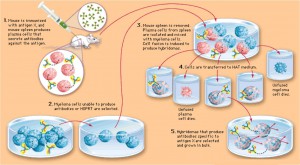Generally, the transporter associated with antigen processing (TAP) is essential for peptide loading onto major histocompatibility class I molecules by translocating peptides into the endoplasmic reticulum. Current invention has provided various agents which are useful with at least one phosphorothioate monoester group.

To be more specific, the invention concerns a method for the preparation of immunogens comprising reacting at least one type of antigens or antigenic determinants which are for example of polypeptide, oligosaccharide or oligonucleotide nature. And the carrier complexes mainly consist of glycosides having a hydrophilic/hydrophobic part and hydrophobic compounds, which might show reactivity towards antigens or antigenic determinants.
1. Crosslinking for Polypeptides and Carrier Proteins
As for the immune response in animals, the molecular weight of most polypeptides is too small. Thus, after the crosslinking of polypeptides to a carrier protein such as KLH, certain antigen size can be enhanced to a higher level, as well as the immunity. Certainly, most customers would choose the crosslinking for KLH because its immunity is very good and it has been used in many trails as Blocking reagent. In addition, because there might be antibodies towards polypeptides (Glycopeptides) and carrier proteins in animals, false positive could appear during the process.
2. Use of Antibodies
Many biological molecules and antibodies are obvious to proteins and peptides, with strong linking capability, so antibodies can jointly occupy the main position in biomedical research. As is known, antibodies have been used in a wide range of areas, such as the characteristics of proteins, determination of dispersal protein analysis, as well as confirmation of other aspects of proteins. Examples can be found in early pregnancy diagnosis kits, protein microalloy, immunohistochemistry and conventional ELISA testing, peptide synthesis, etc. Due to the unique feature, in vivo treatment with antibodies has become a main tool. Successful models include Herceptin for the treatment of a special class of breast cancer, Lymphomas B-cells for particular type medication, and so on.
3. Antigen and Identification Region
In most situation, antigen and immunogen are able to exchange the use of the word, because the difference between them is very small. They mainly indicate certain interaction between molecules and immune system. Immunogen refers to a molecule that can make a biological immune system to occur immune response while antigen is referred as a molecule that relates to such immune response. Therefore, the two elements couldn’t be distinguished at a complete concept. Identification region (epitope) is a particular sequence that connects a single antigen molecule with the antibody; any antigen (antigen protein) is likely to have more than one antibody identification regions. For the production of antibodies, identification region that is easy for the identification of antibody could be the most ideal.
In fact, there are also some other issues for the crosslinking of polypeptides, such as the suitable peptide chain length. Short peptide is generally of no use unless there is sufficient reason, as there is sequence homology with the clan and other proteins. When it comes to the antibody production value, it could depend on many factors. Synthetic polypeptides, immune steps and animal physiological systems are just few of them.